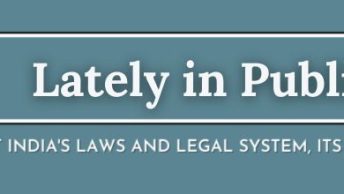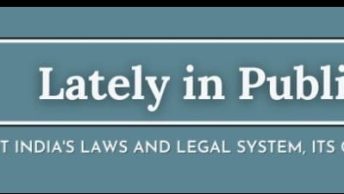A fortnightly feature inspired by I-CONnect’s weekly “What’s New in Public Law” feature that addresses the lacuna of a one-stop-shop public law newsletter in the Indian legal space.
What’s New at LAOT
1. Ishita Bhardwaj, Between NBCC and Silpi: Rethinking the Supreme Court’s duty to label its reasoning (examines the Supreme Court’s judgement in NBCC (India) Ltd. v. Aircon Engineering Services and its treatment of Silpi industries. The piece makes a case for why the Supreme Court should clearly flag and label the legal status of its reasoning to ensure consistency and clarity in Indian jurisprudence).
2. Prof. Hilal Ahmed, Secularism as Misdirection: Response by Hilal Ahmed (provides his comments on the first and second chapters of the book).
Elsewhere Online
1. Parul Raghuwanshi, When Bulldozer Justice Breeds Injustice: Indian Supreme Court Curtails Arbitrary Demolitions, Oxford Human Rights Hub.
2. Rishika Sahgal, The Absolute Prohibition against Punitive Demolitions, Constitutional Law and Philosophy Blog.
3. Shamik Bag, Faith in The Forests: In Jharkhand, A Challenge To Hindutva From Adivasis Following The Ancient Sarna Faith, Article 14.
4. Abhayraj Naik and Parul Kumar, India’s New Constitutional Climate Right, Verfassungsblog.
5. Ahan Basu, R.G Kar Protests and the Reignited Question of Protests on Matters Sub Judice, Vidhi Centre for Legal Policy Blog.
6. T. Sai Sanket Sharma, Expanding Article 21: The Implied Incorporation of Substantive Due Process and its Challenges, Constitutional Law Society, NLUO.
7. S. Irudaya Rajan & J. Retnakumar, Demography, Democracy, and Delimitation, Economic and Political Weekly.
Lately in Academic Articles
1. Ayan Guha, Decoding communist narrative on federalism in India: ideology versus politics, Taylor & Francis (examines how the CPI(M)’s federalist discourse is shaped more by pragmatic political strategy than ideological consistency, revealing its shifting stance, rhetorical use of state autonomy, and contradictory governance practices in light of electoral and neoliberal pressures).
2. S Irudaya Rajan & Retnakumar, Demography, Democracy, and Delimitation, Economic and Political Weekly (critically examines the proposed lifting of the constitutional freeze on Lok Sabha seat delimitation, highlighting southern states’ fears of losing representation due to their demographic progress and questioning the simplistic linkage between population stabilization and representational fairness).
3. Anshika Singh, Balancing Articles 25–28 with Article 44 of the Indian Constitution: Religious Freedom vs. Uniform Civil Code, Journal of Constitutional Law and Jurisprudence (explores the constitutional tension between personal religious freedoms and the state’s objective of enacting Uniform Civil Code, advocating for a harmonised, inclusive approach grounded in judicial precedents and legislative practice).
4. Sukriti Goyat, Anti-beggary laws in India: a socio-political critique, International Journal of Public Law and Policy (critiques India’s anti-beggary laws as remnants of colonial vagrancy legislation that disproportionately criminalise the poor and homeless, highlighting judicial interventions like the partial striking down of the Bombay Prevention of Begging Act, 1959, and calling for rights-based reform).
5. Taniya Malik, Balancing Tradition and Gender Justice: Revisiting Section 9 of the Hindu Marriage Act and Its Impact on Women’s Autonomy and Constitutional Rights, In(Visible) Signs of Gender-Based Violence (critiques the restitution of conjugal rights provision in the HMA as a violation of women’s bodily autonomy, arguing for its abolition on constitutional and human rights grounds, especially in light of India’s non-criminalisation of marital rape).
6. M Mohsin Alam Bhat, India’s Communal Constitution: Law, Religion, and the Making of a People, Journal of Church and State (examines John’s argument that postcolonial India’s constitutional framework structurally reproduces colonial-era communal categories, identifying this as a “constitutional failure” rooted in the legal recognition of religious identity).
Listen Up
1. Jasti Chelmaseswar, Constitutional Interpreation and Judicial Independence, Ideas of India (speaks about the judgments on electoral qualifications, judicial conduct, transparency in judicial appointments, the constitutional right to privacy and how dissent shapes constitutional interpretation)
2. The Print Podcasts, What has the Centre Told SC on Waqf Act? (discusses the pleadings of the government in the Supreme Court in the Waqf Act).
3. Dr. Anita Chan, Big Tech and Feminist Practice, Feminist Law (talks about the relationship between Big Tech, eugenics, and the exploitation of women)
4. How does Section 44(3) of the DPDP Act weaken the RTI? – In Focus by The Hindu | Podcast on Spotify (discusses Section 44 (3) of the Digital Personal Data Protection Act, 2023, and how it weakens the Right to Information Act and its consequences.)
5. The Hindu Podcast, How can India strengthen the foundations of its justice delivery system? – In Focus by (discusses how India can strengthen the foundations of its justice delivery system in the backdrop of recent corruption allegations against a Delhi HC judge).
6. Friends of the Court Podcast, Justice Saiyid Fazl Ali (delves into the life and work of Justice Fazl Ali and the afterlife of his AK Gopalan judgement.)
Opportunities
1. Blog Writing Competition on ‘Mental Health, Disability & Rights’ by HPNLU Shimla. The last date to submit is May 18, 2025.
2. Call for Papers: DNLU Journal of Legal Studies [Vol 3 (2025); ISSN Publication]: Submit by June 15, 2025.
3. Call for Papers by Oxford Intersections by the University of Oxford. The last date to submit is May 17, 2025.
4. Call for Papers by RGNUL Student Research Review (RSRR) Journal [Vol 11; Issue 1]. The last date to submit is June 15, 2025.
5. Call for Papers: International Conference on ‘Role of International Trade in Global Energy Transition’ by NLUO, Cuttack. The last date to submit abstract is June 15.





Mersin Emlak
Win Gayrimenkul
Mersin Satılık Villa
I just discovered a very affordable dedicated server, perfect for growing businesses!
I just discovered a very affordable dedicated server, perfect for growing businesses!
Gutes Preis-Leistungs-Verhältnis beim Hosting – sehr empfehlenswert.
Selam, uygun fiyatlı OpenCart hosting buldum, e-ticaret sitesi kurmak isteyenlere birebir!
Merhaba, fiziksel sunucu kiralamak isteyenlere mükemmel bir fırsat buldum!
Mersin Emlak
Mersin Satılık Konut
Mersin Satılık Arsa
Mersin Satılık Arsa
Tiktok İzlenme al
Mersin Kiralık Daire
İnstagram Takipçi Al
Mersin Kiralık Daire
Mersin Satılık Arsa
特に「耳かき系」や「環境音系」のASMRが好きで、実際に比較したレビューをこちらにまとめました
Tiktok beğeni satın al
特に「耳かき系」や「環境音系」のASMRが好きで、実際に比較したレビューをこちらにまとめました
Tiktok İzlenme al
ASMRってジャンルが本当に多くて奥が深いですね。
I do believe all the ideas youve presented for your post They are really convincing and will certainly work Nonetheless the posts are too short for novices May just you please lengthen them a little from subsequent time Thanks for the post
Somebody essentially help to make significantly articles Id state This is the first time I frequented your web page and up to now I surprised with the research you made to make this actual post incredible Fantastic job
Thank you for the auspicious writeup It in fact was a amusement account it Look advanced to far added agreeable from you However how can we communicate
Ive read several just right stuff here Certainly price bookmarking for revisiting I wonder how a lot effort you place to create this kind of great informative website
Somebody essentially help to make significantly articles Id state This is the first time I frequented your web page and up to now I surprised with the research you made to make this actual post incredible Fantastic job
Usually I do not read article on blogs however I would like to say that this writeup very compelled me to take a look at and do it Your writing style has been amazed me Thank you very nice article
if you are looking free temp mail service with premium features and lots of domain , then 0mail is number one provider without any cost. simply search on google as “Temp Mail for Facebook – The Ultimate Guide 0mail pro” or click in my profile url to get the site access. can use them on discord or any others social media, all are premium domains updated daily and many more features.
Mersin Emlak
If you are looking for an AI essay writing service, it is worth taking a look at the review of Perfect Essay Writer – https://nocramming.com/ai/perfect-essay-writer. The article discusses in detail the platform’s features, usability and the quality of the texts created. Useful for those who want to save time, but not lose quality.